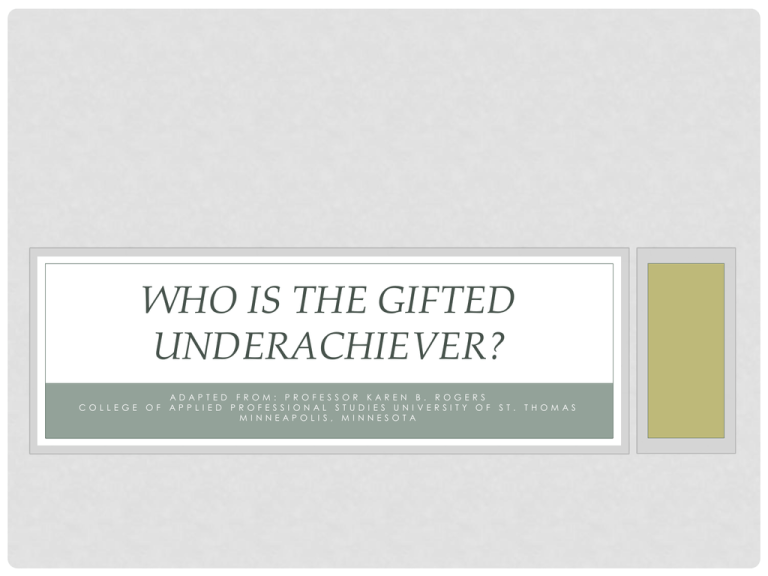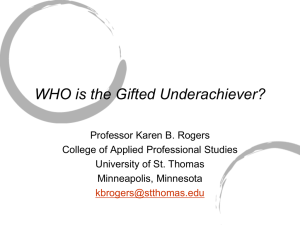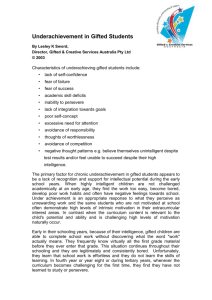Underachievement - highimpactemotional
advertisement

WHO IS THE GIFTED UNDERACHIEVER? COLLEGE OF ADAPTED FROM: PROFESSOR KAREN B. ROGERS APPLI ED PROFESSI ONAL STUDI ES UNI VERSITY OF MINNEAPOLI S, MINNESOTA ST. THOMAS STEPHANIE • Stephanie is a 5th grade student whose evaluation comments read like a list of missed opportunities. “Stephanie is bright, but seems insecure about her ability to do well; her perfectionism prevents her from pursuing new topics or projects.” In class, Stephanie seldom causes trouble; in fact, you hardly know she’s there. She pursues work with caution, and when her teacher hands her an assignment, she immediately thinks it is too hard for her to do. Often she is her own worst enemy. When she does well on a project, she attributes it to “being lucky” and when she does not do well, she internalizes her failure and calls herself “dumb”. She would like to do better in school but claims she cannot. She insists she is not as smart as everyone says and she can prove it by showing you all her low marks and poor papers. To the casual observer, she is a nice, quiet girl who just lacks self-confidence. To the careful observer, she is a sad girl who seems to have little hope of ever being anything more than she is right now: self-critical, deprecating, and unable to chart her own social or academic course. MARK • Mark is a student most teachers hear about before they ever meet him. His reputation precedes him because he is the source of constant staffroom banter: “You’ve got to approach him just so, or else he will walk all over you; he’s a smart kid, and he knows it --that’s his biggest problem.” On some days he is the most animated discussant in a review of current world events. On other days, he just sits there, completing seatwork when he feels like it and turning in homework when the mood strikes him. Mark dislikes “busy work” and the teachers who assign it. He succeeds on projects that peak his interest, often concentrating solely on them to the exclusion of other tasks. This makes it difficult for teachers to assign grades. They know Mark understands the concepts taught but if he refuses to turn in all the required work, how can they possibly reward him with high grades? Getting good grades is not one of his personal goals. He is into learning but often does not see school as the place where that can occur. To the casual observer, Mark rebels for the sake of rebelling. To the careful observer, he knows what he knows and doesn’t want to keep proving it. FOUR MAJOR RESEARCHERS ON UNDERACHIEVEMENT • Sylvia Rimm, The Underachievement Syndrome: Causes and Cures • Barbara Clark, Growing Up Gifted • Diane Heacox, Up From Underachievement • James Delisle, When Gifted Kids Don’t Have All the Answers RIMM’S UNDERACHIEVEMENT “SYNDROME” • Identified 13 different forms of underachievement represented as fictional characters.Their underachievement has been “shaped” by their home, school climate, unrewarding curriculum, and personal flaws: Manipulative Mary, Taunted Terrence, Depressed Donna, Passive Paul, Jock Jack, Academic Alice, Torn Tommy, Rebellious Rebecca, Dramatic Dick, Hyperactive Harry, Perfectionist Pearl, Adopted Annie, and Creative Chris RIMM’S SYNDROME (2) • All underachievers, whether dependent or dominant in their behavior exhibit: • • • • • • Forgetfulness Disorganization Carelessness and superficiality on tasks Non-academic interests Manipulation of relations with parents and teachers Loneliness and social withdrawal RIMM’S SYNDROME (3) • Home origins of underachievement: • • • • • The over welcome child Early illness Birth order (later, not first) Marital discord Conflicting parenting styles • • • • Kind mom/ogre dad Wonderful dad/ogre mom Dummy dad Mousy mom RIMM’S SYNDROME (4) A trifocal approach can “cure” the syndrome Child is monitored by home and school so that tasks are noted and completed, assignments turned in. System of behavior modification is used to re-shape the behaviors Parent must carry out what school requires child to do, ensuring schedule, space, and monitoring of child’s work outside of school. Daily/weekly reports are provided for the school. Parents are counseled when discord or conflicts are present School develops plan for child and parents to follow, notes when the plan has been followed and reinforces achieving behaviors when observed in the child CLARK’S UNDERACHIEVEMENT CHARACTERISTICS • There are 16 characteristics or behaviors that gifted underachievers exhibit to at least some degree, some of which are personal-related and some of which are school-related. Just knowing these behaviors are there is the first step to overcoming the responses (and choices) the underachiever makes. CLARK’S CHARACTERISTICS Personal Low self-concept, negative selfevaluation Social immaturity, unpopular with peers Choose companions who do not like school Feelings of rejection, helplessness, feeling victimized School Lack of discipline in tasks, high distractibility Don’t see connection between effort and achievement outcomes Few strong hobbies or interests Resistant to influence from teachers, parents CLARK’S CHARACTERISTICS (2) Personal Hostile toward adult authority figures Low aspirations for future, career, less persistent and assertive Externalization of conflicts, problems School Withdraw in classroom situations Lack of study skills, Weak academic motivation Leave schoolwork incomplete, nap during study times Perform well on synthesis tasks but not on tasks requiring precise, analytic processing HEACOX’S UP FROM UNDERACHIEVEMENT • Gifted Achiever • Pride in own work and effort • Resilience when things go wrong • Practice risk taking • Self-disciplined • Goal-oriented --set out plan for own work and follow through • Gifted Underachiever • Poor academic selfconcept, poor organization • External locus of control • Perfectionism, so unlikely to take risks • Independent --insist on doing only what they want to do • Discrepancy between oral and written work HEACOX STRATEGIES • Single-sided interests • Identify “acceptable minimums for tasks • Pick up pace of instruction • Identify “have to have” skills and focus on these • Help child focus on their single-sided interests HEACOX STRATEGIES (2) • Claims of boredom • Develop diagnosticprescriptive instruction • Compact the regular curriculum • Use continuous progress for learning • Fast paced content presentations • Subject acceleration • Find “cause” of boredom HEACOX STRATEGIES (3) • Perfectionism • Teach strategies for when to quit, how to match effort to tasks, setting goals, focusing on successes not failures, and separating self-concept from products • Role model mistake making HEACOX STRATEGIES (4) • Peer Pressure to Underachieve • Selectively encourage certain friendships • Take interest in child’s friends • Encourage extracurricular activities • Teach strategies for resisting peer pressure HEACOX STRATEGIES (5) • Lack of Organizational Skills • Study habits training • Strategies for developing work plans, priorities, balance, flexibility • Provide consistent space and schedule for study at home HEACOX STRATEGIES (6) • Stress • Teach time management techniques • Relaxation exercises • Exercise routines • Socialization opportunities DELISLE’S DIFFERENCES IN TYPES OF UNDERACHIEVEMENT • Non-Producer/ Selective Consumer • Mentally healthy • Can explain both problem and possible solutions • Independent and proactive • See teachers as adversaries and are contentious • Underachiever • Psychologically at risk • Does not understand causes or cures • Dependent and reactive • Respects or fears authority figures DELISLE’S DIFFERENCES IN TYPES OF UNDERACHIEVEMENT (2) • Non-Producer/ Selective Consumer • Counseling needs are minimal • Requires little structure, needs breathing room • Performance varies relative to teacher and content • Underachiever • Strong counseling program needed • Needs both structure and imposed limits • Performance uniformly weak DELISLE’S DIFFERENCES IN TYPES OF UNDERACHIEVEMENT (3) • Non-Producer/ Selective Consumer • Can be dealt with within school resources • Change may occur overnight • Frequently satisfied with accomplishments • Sees self as academically able • Underachiever • Requires family intervention • Change is long term • Often perfectionistic, nothing is ever good enough • Poor academic selfesteem COMMONALITIES BETWEEN TWO FORMS OF UNDERACHIEVEMENT • Socialization with classmates may be impaired • Prefer “family” versus “factory” classroom atmosphere • Needs to change both behaviors and attitudes • May need guidance or counseling to achieve academic success DELISLE’S STRATEGIES FOR IMPROVING ACADEMIC PERFORMANCE • Supportive Strategies • Behaviors that affirm the worth of the child in the classroom and convey the promise of greater potential and success yet to be discovered and enjoyed • Intrinsic Strategies • Behaviors that are designed to develop intrinsic achievement motivation through the child’s discovery of the rewards available as a result of efforts to learn, achieve, and contribute to the group • Remedial Strategies • Behaviors that are used to improve the student’s academic performance in an area of learning difficulty which led to experience of failure and loss of motivation to engage in learning tasks HIDING GIFTS • Play dumb” to blend in and make friends with other children their age. • Girls are especially vulnerable as they reach adolescence. • May feel overwhelmed by their abilities and just want to be “normal kids.” • Adults can help by celebrating and encouraging their abilities. SUPPORTIVE STRATEGIES • Non-Producer • Eliminate work already mastered • Allow independent study on topics of personal interest • Nonauthoritarian atmosphere • Permit students to prove competence via multiple methods • Teach through problem solving rather than rote drill • Underachiever • Daily class meetings to discuss student’s concerns • Directive atmosphere to show who is in charge • Daily written contracts of work to be done • Free time scheduled each day to show import of relaxation, free choice • Use of concrete, predictable teaching methods INTRINSIC STRATEGIES • Non-Producer • Student helps determine class rules • Assign specific responsibilities for classroom maintenance, management • Practice reflective listening, comment to clarify student statements • Student sets daily/weekly/monthly goals with teacher approval • Underachiever • Daily review of/reward for small successes • Allow students to evaluate work prior to teacher marking • Frequent, positive contact with family about child’s progress • Verbal praise for any selfinitiating behaviors REMEDIAL STRATEGIES • Non-Producer • Self-selected weekly goals for improvement • Private instruction in areas of weakness • Use of humor and personal example to approach academic weakness areas • Familiarize students with learning styles and personal implications for performance • Underachiever • Programmed instruction materials, students grade own papers upon completion • Peer tutoring of younger students in areas of strength • Small group instruction in common areas of weakness • Encourage students to work on projects not involving marks or external evaluation FINDING THE RIGHT APPROACH • When approaching any problem, there are two general lines of attack: the “shotgun” approach, where strategies are applied willy-nilly in hopes that something will hits its target, and the “spotlight” approach, where a sharp, precise beam is focused on a specific situation or problem. In issues as complex as underachievement and selective consumerism, time and effort spent on locating the target will result ultimately in more effective and efficient treatment strategies. FINDING THE RIGHT APPROACH • The child who chooses not to perform up to others’ expectations --the selective consumer --reminds us of the old adage, “You can lead a horse to water, but you can’t make him drink. With just a little editorial license, this new proverb describes such a case: “You can lead a child to knowledge, but you can’t make him think. FINDING THE RIGHT APPROACH • For the truly underachieving child who has little control over or understanding of his or her depressed performance, the myth of Narcissus seems to apply. This character, who upon seeing his reflection in a pond, pined away for the lovely creature he saw. He longed for something he already had, so his was not a problem of attainment but of realization. And just as Narcissus was eventually transformed into a beautiful flower, so might the child with underachieving behaviors come into full bloom, given the proper mix of support and nurturance. (Delisle, 2002, p. 180) ASYNCHRONOUS DEVELOPMENT OUT – OF – SYNC OR UNEVEN DEVELOPMENT GIFTEDNESS “Giftedness is asynchronous development in which advanced cognitive abilities and heightened intensity combine to create inner experiences and awareness that are qualitatively different from the norm. This asynchrony increases with higher intellectual capacity. The uniqueness of the gifted renders them particularly vulnerable and requires modifications in parenting, teaching and counseling in order for them to develop optimally.” (The Columbus Group, 1991) DEFINITIONS “To have the intelligence of an adult and the emotions of a child combined in a childish body is to encounter certain difficulties.” (Hollingworth, 1942) “In addition to being out of sync in their own development, gifted children are out of sync: with family relations, both parents and siblings, socially with age-peers and older, and with schools and the larger community.” (Kearney, 1991) THESE STUDENTS…. • Often function at one level intellectually, another socially and yet another emotionally. For example, a gifted five-year-old can be discussing the problem of world hunger one minute and the next minute throwing a tantrum because he has to go to bed. • A gifted child who is years ahead of his or her age mates is not always years ahead emotionally or socially. Advanced intellectual ability simply does not enable a child to manage emotions any better than any other child. THESE STUDENTS…. • Have been described as “old souls in young bodies.” • May sound like “little adults,” then are criticized when they act like the children that they are. A five-year-old who can discuss world hunger like a ten-year-old is often expected to behave like a tenyear-old. When he acts like a five-year-old instead, a parent (or teacher) comes to see that behavior as immature behavior. TWICE EXCEPTIONAL • In addition to having asynchrony between their intellectual and physical development, they have extreme asynchrony between intellectual development and the ability to express or use that intellect. • An LD student may be able to play a musical instrument at a high level by ear, but will struggle with reading individual notes. Difficulties like these, unfortunately, often lead to the child just giving up instead of taking the extra time to come up with strategies which will help the child. TWICE EXCEPTIONAL • gifted and mildly dyslexic, it means being bored to tears in math and science classes because they are too easy, while struggling to read grade-level books. It means not being able to read books that discuss science and other topics at his level of understanding. It means finding reading class books challenging, but the classroom discussions excruciatingly boring. TWICE EXCEPTIONAL • gifted and has dysgraphia (extreme difficulties with writing), being gifted/special needs means having his hands get cramped and tired after only one page of writing. It means being unable to write and think at the same time, so that his written work doesn't come anywhere near reflecting the depth of his thoughts. It means he is thinking about math concepts that his teachers don't understand, but having trouble writing them down. TWICE EXCEPTIONAL • gifted and has ADHD, being gifted/special needs means getting assignments wrong because he missed some of the instructions and therefore did the wrong thing correctly. It means getting into trouble for not paying attention because he is incapable of focusing on multi-step oral instructions, but seems too smart to not understand what he is supposed to do. It means getting in trouble for losing control at the end of the day, when he is tired and his medication has worn off because "you're too smart to forget the rules". WHAT CAN TEACHERS AND PARENTS DO ABOUT ASYNCHRONOUS DEVELOPMENT? Nothing can be done to change the way children develop, so asynchronous development can't be corrected or altered. However, life in at school and home with an asynchronous child can be made easier when we understand that development. Here are some quick tips: REMEMBER THEIR AGE • Recognize that a gifted child's emotional and social development will not always match his or her intellectual development. Before responding to your child's emotional outburst or concluding that your child is socially or emotionally immature, stop a moment to remind yourself of your child's chronological age. PROVIDE EMOTIONAL SUPPORT • Understand that asynchronous development creates special needs. For example, gifted children need emotional support as do all children, but they also need advanced intellectual stimulation. A gifted four-year-old who can discuss black holes still needs comforting hugs. OPPORTUNITY TO INTERACT WITH INTELLECTUAL PEERS • Recognize that gifted children may not get their emotional, social, and intellectual needs met by the same peers. This means that they may be able to socialize to a degree with children their own age, but may also need opportunities to interact with other gifted children, older children, or even adults. Parents should make every effort to provide these opportunities.




